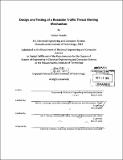| dc.contributor.advisor | Mary L. Cummings and Erin T. Solovey. | en_US |
| dc.contributor.author | Powale, Pallavi | en_US |
| dc.contributor.other | Massachusetts Institute of Technology. Department of Electrical Engineering and Computer Science. | en_US |
| dc.date.accessioned | 2014-03-19T15:46:13Z | |
| dc.date.available | 2014-03-19T15:46:13Z | |
| dc.date.issued | 2013 | en_US |
| dc.identifier.uri | http://hdl.handle.net/1721.1/85800 | |
| dc.description | Thesis: M. Eng., Massachusetts Institute of Technology, Department of Electrical Engineering and Computer Science, June 2013. | en_US |
| dc.description | "May 2013." Cataloged from PDF version of thesis. | en_US |
| dc.description | Includes bibliographical references (pages 119-122). | en_US |
| dc.description.abstract | Every year, law enforcement officials, emergency personnel, and other workers stopped in traffic outside their vehicles are struck by inattentive drivers. Until now, most efforts to prevent these types of accidents have been geared toward making these at-risk parties more conspicuous to oncoming motorists. In contrast, this work proposes an alerting mechanism designed specifically to induce defensive behavior on the part of the at-risk officers (or other roadside personnel), once a hazardous situation has been detected. The immediate objective of this research was to produce an effective alarm prototype for a high noise, low-light operation environment such as a dimly lit highway shoulder. Based on fieldwork and background research, four such prototypes were engineered and evaluated for user response speed and subjective preference. Two of these alarm prototypes were auditory sirens and two were haptic vibrations, one placed at the waist, and one at the wrist. Haptic vibrations, which we hypothesized would be more salient in a loud and visually stimulating environment, proved to induce statistically significantly faster responses than the auditory alarms and were well received by the user community of State Police. The auditory sirens, however, were perceived as significantly more urgent than the haptic alarms and would be a beneficial addition to the haptic device to add redundancy to the system. Implemented in highway safety systems, the warning system developed through this work has the potential to help save lives. | en_US |
| dc.description.statementofresponsibility | by Pallavi Powale. | en_US |
| dc.format.extent | 122 pages | en_US |
| dc.language.iso | eng | en_US |
| dc.publisher | Massachusetts Institute of Technology | en_US |
| dc.rights | M.I.T. theses are protected by copyright. They may be viewed from this source for any purpose, but reproduction or distribution in any format is prohibited without written permission. See provided URL for inquiries about permission. | en_US |
| dc.rights.uri | http://dspace.mit.edu/handle/1721.1/7582 | en_US |
| dc.subject | Electrical Engineering and Computer Science. | en_US |
| dc.title | Design and testing of a roadside traffic threat alerting mechanism | en_US |
| dc.type | Thesis | en_US |
| dc.description.degree | M. Eng. | en_US |
| dc.contributor.department | Massachusetts Institute of Technology. Department of Electrical Engineering and Computer Science | |
| dc.identifier.oclc | 871715111 | en_US |
